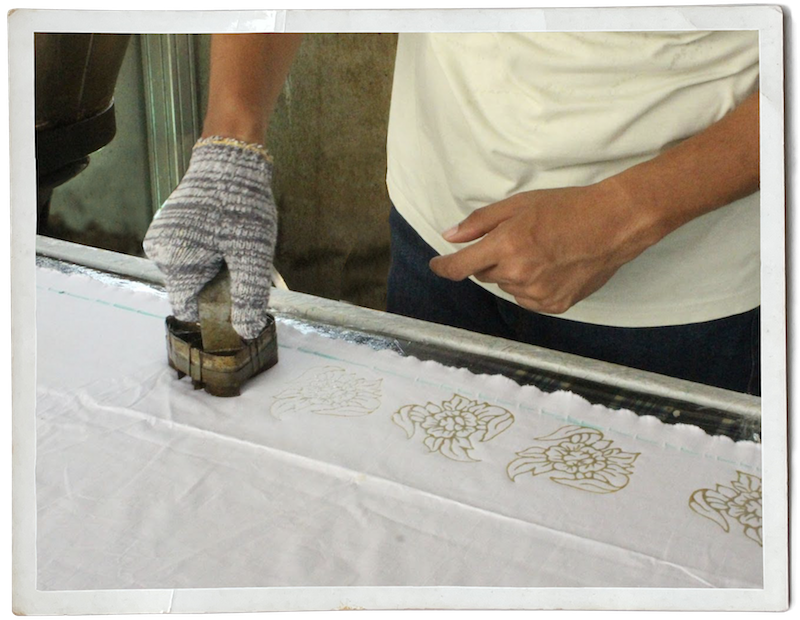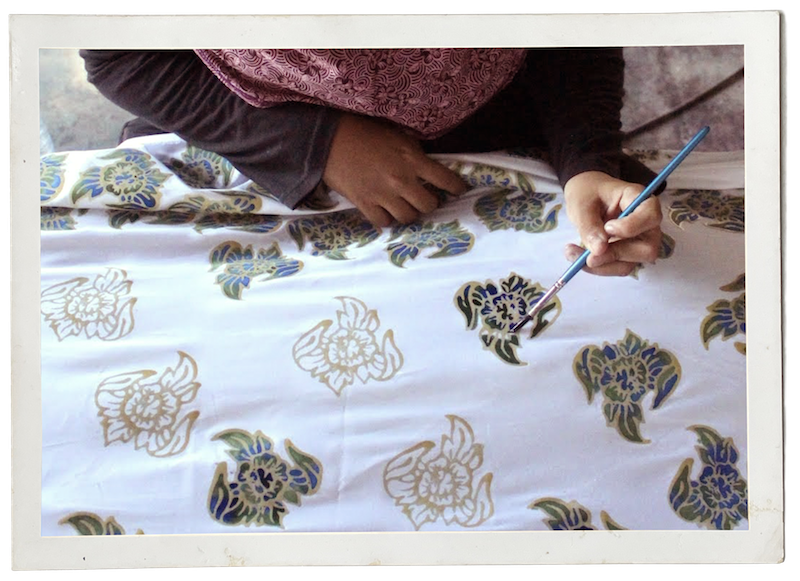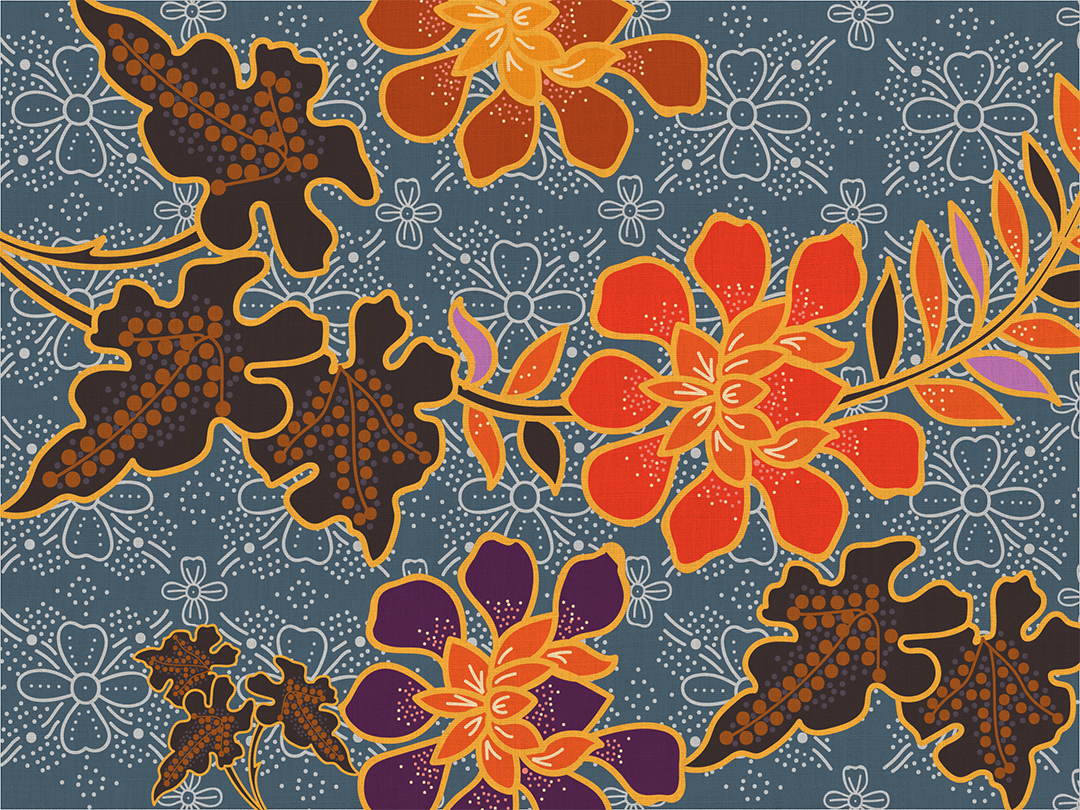
Malaysian batik makes a unique case study — although a lot has been discussed about it, little is understood, and not much has been done. Today, what is popularly known about Malaysian batik is from a tourism currency perspective — what foreign visitors like to buy when they visit the country and so we must keep producing it. Why and how are often unclear. The sequence of its value chain somewhat breaks down and disintegrates in the translation.
While enthusiasts tend to describe batik from an aesthetic point of view, experts are not adequately positioned in society to relay the right information where it’s critically needed. This includes government schools, higher learning institutions such as polytechnics, and government-linked companies. Critics, aplenty, offer nothing less than comparison to other types of batik, namely to the more superior ones from Indonesia. Everyone is entitled to their opinion. Yet when asked why we are divided, many are quick to lament, “This is due to lack of education!”. Yes, that is not untrue. As a lover, collector, and entrepreneur of Malaysian batik, I say the problem stems from lack of love.
… you cannot remove or ignore the historical and technical components of batik making in order to understand its identity.
Firstly, you cannot remove or ignore the historical and technical components of batik making in order to understand its identity. The batik we are wearing in Malaysia today is an amalgamation of circa 300 years of Southeast Asian artistic influence that is rooted in an art technique that has been performed for over 2000 years around the world. You need a love for cultural and historical studies to grasp its uniqueness. If not love, a high level of patience to appreciate its explanation. Thus, what is batik?
Batik is a form of resist art (This is not to be confused with Resistance Art, a form of art that emerged in South Africa in the mid-1970s after the Soweto uprising that focused on resisting apartheid and celebrating African strength and unity.) Batik is both an art and a craft, a noun and a verb. Taken from the Malay word (Malay here refers to the language of the Malay world or kingdom which means Malaysia and Indonesian) ‘tik’ from ‘titik’ translated as dot in English. And thus, batik is as much to make an impression on a surface, as it is the endeavor of producing the art. Note that I use the word endeavor for creating batik, which is a laborious process.
Batik uses hot wax in a process called canting that utilizes a pipe with a tiny spout made out of copper. To create a batik, selected areas of the design are blocked out by pouring this hot wax from the spout. A copper block can also be used to create the design, and it is not unusual to find both tools used in one composition.
A dye is applied over the top so that the parts covered in wax resist the dye and retain the original colour. A simple batik may be just one layer of wax and one dye, but this process of waxing and dyeing can be repeated many times (up to seven if necessary) to create more elaborate and colourful designs. The colours are “fixed” using sodium silicate and the wax is removed by boiling.
Drying the fabric must be out in the open with sufficient breeze and sunlight. This is important for the absorption of colours. This is why you often see batik drying by roadsides, beaches, and practically any available uncovered areas along the coastal towns of Kelantan and Terengganu. Once dried the cloth is ready for wearing or displaying. These pieces of cloth can range from a meter to five though production slows during the monsoon season.
Batik has become over-priced due to who is wearing it rather than who made it.
Price point depends on the complexity of design and number of layers added to the raw fabric. Unfortunately, today branding influences the price. And in Malaysia, creeping into this influence is the clientele. Batik has become over-priced due to who is wearing it rather than who made it.
A craftsman or collector will explain that price is based on origin, type, and workmanship. Under the umbrella term resist art is resist dyeing that has been practised for millennia in different parts of the world. Resist dyeing is a means of patterning the surface of a woven cloth (tie-dye) or unwoven threads by restricting the penetration of dyes (ikat). This brings us to tie dyes. Southeast Asia was once a pivotal center of textile production and trade. Incidentally, according to etymology, the Malay word for tie dyeing is “pelangi”, which literally means rainbow. Popularized in the 1960s and 1970s by the hippie subculture in the Western world, the swirling patterns and psychedelic colours of the era’s tie-dyed garments remain to this day embodiments of spontaneity. In Malaysia, tie-dye is within the family of batik for its resistant nature and one can often find a composition that combines the wax design of batik with the tie-dye process. Other varieties include ikat (more complex and less well known in central Asia like Uzbekistan) and shibori (still popular and increasingly so in Japan). A collector will select based on these factors and prioritize provenance and longevity. A customer will ask, “How much?” followed by “Why is it so expensive? Can I get a discount?” and negate the historical component that validates the price.

Today, batik faces threats from digital printing. High production, high margin, low cost, more variety. Currently trending is “batik viral”, a two-meter cloth that looks like authentic hand-made batik but is printed digitally. Fabric-wise it feels smooth, cool, and soft, and costs RM10. This alone should give you a hint or rather, a red flag. When a fabric feels soft and cool at extremely low price it’s a poly-blend. Poly-blends look vibrant, last longer, require little to no ironing. Unfortunately, they suffocate the skin in humid weather when you perspire, and pollute the environment. Burn the fabric and you can tell from a plastic-like odor and thick smoke. Fire victims suffer most from melted poly-blends that the flesh thus require grafting.
Batik uses natural fibre (cotton and silk) whereby the wax flows smoothly and pigment absorbs more significantly so that the designer is able to control tonality and flow of the colours. Salt and sugar are often used to create ripple and marble effects once the cloth is soaked with dye. This creates a 3-D like effect which cannot be emulated by digital superiority. Sorry, some things technology cannot outdo an artisan.
Even if you’re not a history buff, there are other aspects of the batik story and its journey that will resonate with you.
In my experience it’s difficult to not fall in love with batik once you achieve an understanding. Even if you’re not a history buff, there are other aspects of the batik story and its journey that will resonate with you. This could be technique, variety, textile, geography, or business. At the very heart, it’s about people. That is how I became hooked. I spoke to a few local folks while I was in Kuala Terengganu in 2012. They shared with me community stories surrounding batik and its spiritual importance. Instead of lamenting their struggles, fishing for pity, or scaring me with ghost stories, they opened their homes, offered me food, and taught me batik with the wisdom that was passed down to them. “You cannot separate art and craft from its natural environment, and this includes its spirituality. It is not syirik. “That’s politics and propaganda,” they told me. “Since you are a teacher, you should educate people not to confuse the two. Look at Indonesia.” Coincidentally, I did go to Indonesia. There, I was exposed to the pedigree and symbolism of batik. Today as both entrepreneur and collector working closely with the craftsmen, I feel a need to strengthen policies that govern and protect traditional arts and crafts known as intangible heritage.
Personally, I feel a lot of what we do know about batik in Malaysia today is credited to the people and government of Indonesia. Indonesia began celebrating “Batik Day” on 2 October 2009, after UNESCO designated Indonesian batik as a Masterpiece of Oral and Intangible Heritage of Humanity in the same year. The celebration of Batik Day was supported by the Oriental Cultural Heritage Sites Protection Alliance, a UNESCO long-time partner in the promotion of Asian heritage. This acknowledgement is critical for three reasons:
- Protects Indonesian batik as both an art and craft not just within the perimeters of the Indonesian government and its republic, but internationally. This positioning elevates Indonesian batik production as well as protects pricing.
- Increases projects promoting youth cultural start-ups around iconic heritage sites.
- Substantially increases the number of youth and adults who have/develop relevant skills, including technical and vocational skills, for employment, decent jobs, and entrepreneurship.
- Ensures women’s full and effective participation and equal opportunities for leadership at all levels of decision-making in political, economic, and public life.
Malaysian batik has lost its fervour because we waste too much energy criticising designs, comparing prices, and spend very little learning. Often, criticism comes from lack of knowing, and fear from ignorance.
Schools and learning institutions can play pivotal roles in several ways:
- Promote teaching traditional arts and crafts. Theory alone won’t suffice. Experiential learning that includes visits, overnight stays and sessions with mastercraftsmen are important. Focus on asking many questions. Observation-based trips are as useful as watching paint dry.
- Create sessions that combine entrepreneurs, environmental researchers and craftsmen for a holistic learning exchange on ecosystems. Use the model: what works, what doesn’t, what can change?
- Design more cross-cultural projects that push students to engage with rural communities. Language should not be a barrier. Intergenerational projects make powerful studies because human subjects become walking libraries. Craftsmen are artisans. No books carry their stories. Stories come directly from them.
- Encourage students to use their language and viewpoint to educate others such as Tik Tok and Instagram.
The next article will discuss design, inspiration and artistry.


Hi Natasha, I am looking for batik copper blocks to produce a backdrop and would like to get in touch with some tukang batik that make these batik copper blocks. Do you happen to have their contacts? Thanks.
Hi Dee Mei, thanks for the question. Yes I do. Have emailed directly. Cheers, Natasha
Hello Natasha, my daughter would like to print your 3-part series on Batik as part of her school’a book week. They’re suppose to bring a book to share but she wanted to bring something batik related to showcase her Malaysian heritage (we live in HK now). May we get your permission to print this into a booklet? Thank you in advanced!
Hi Wen, thank you for your message. Sure, by all means. Go for it! Cheers, Natasha.
Hi Wen, sure go ahead. Thanks for choosing my piece! Cheers.